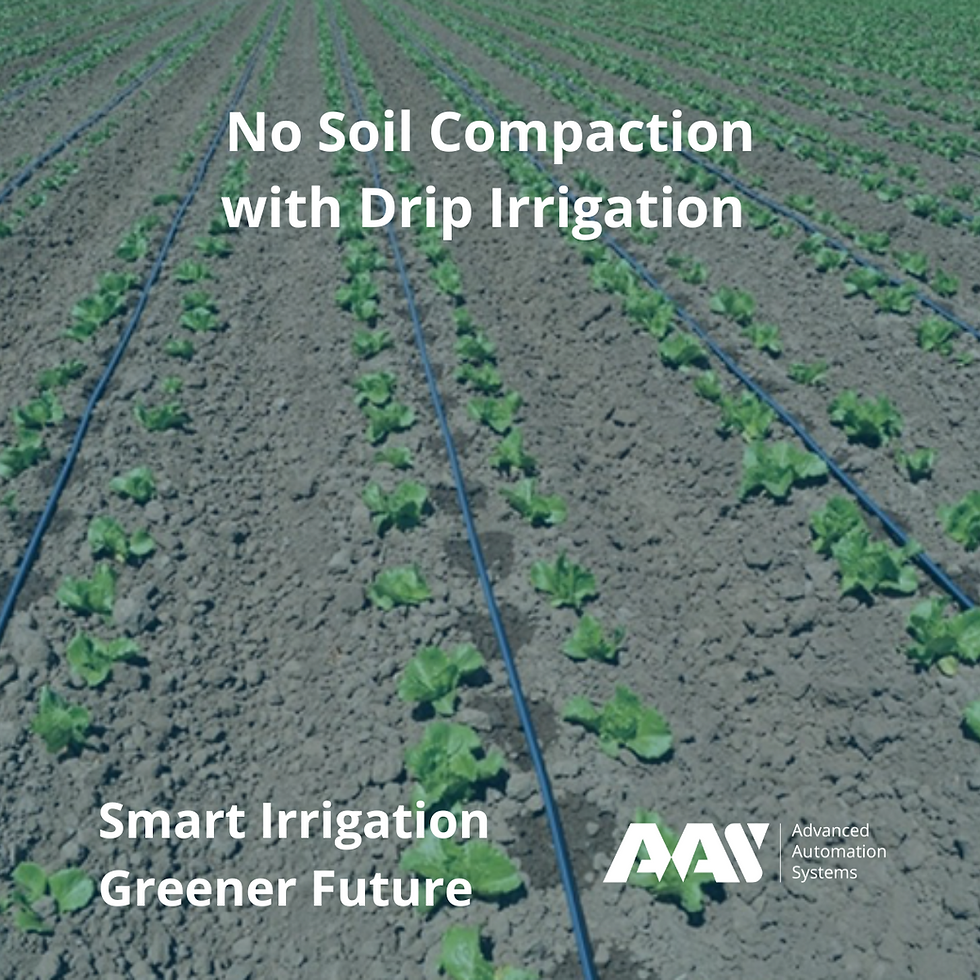No Soil Compaction with Drip Irrigation
- A.A.S.

- Sep 5
- 3 min read
Why Drip Irrigation Dramatically Reduces Soil Compaction
Soil compaction occurs when soil particles are pressed together, reducing pore space. This is primarily caused by:
The Impact Force of Water: High-pressure systems like sprinklers or flood irrigation hit the soil surface with significant force. This impact breaks up soil aggregates and drives fine particles into the pore spaces, sealing the surface and creating a hard crust.
Traffic on Wet Soil: When large areas are watered, people and machinery often need to move through the wet fields for maintenance or inspection, which severely compacts the soil.
Drip irrigation eliminates or drastically reduces these factors:
No Water Impact: Drip emitters release water slowly and gently at low pressure, directly to the root zone. There is no forceful impact on the soil surface. The water simply percolates downward and laterally through the soil via capillary action, mimicking a slow, natural rainfall. This preserves the soil structure and aggregates.
Targeted Application: Only the precise area around the drip line becomes wet. The pathways between rows and most of the soil surface remain dry and firm. This allows for access with foot traffic or machinery without compacting the critical root zone where plants are growing.
Maintained Soil Porosity: Because the soil structure isn't being pounded by water, the natural pore spaces remain open. This is crucial for root growth, oxygen exchange (aeration), and water infiltration.
Comparison to Other Irrigation Methods
Irrigation Method | Impact on Soil Compaction | Reason |
Drip / Trickle | Very Low to None | Low pressure, no impact, targeted watering. |
Sprinkler (Overhead) | Moderate to High | Water droplets hit soil surface with force, destroying aggregates. |
Flood / Furrow | Very High | Large volume of water saturates the entire field, leading to massive particle dispersion and deep compaction upon drying. Promotes crusting. |
Hand Watering | Low | Gentle if done carefully, but often results in surface pooling and minor crusting. |
Best Practices to Ensure Zero Compaction with Drip
To maximize the soil-structure benefits of your drip system:
Mulch! Applying a layer of organic mulch (wood chips, straw, compost) over your drip lines is the single best practice. It completely eliminates any risk of surface crusting, conserves water, suppresses weeds, and feeds the soil biology.
Monitor Moisture: Use a soil moisture sensor or simply dig a small hole to check. Avoid over-irrigating and saturating the soil more than necessary. A well-managed drip system keeps the soil at ideal moisture without waterlogging.
Stay Off the Wet Zones: When you need to access the garden for maintenance, do so when the soil is drier, or ensure you only walk on the designated dry pathways.
Build Soil Health: Regularly add organic matter. Healthy soil with good fungal and bacterial activity creates stable aggregates that are highly resistant to compaction from any cause.
Conclusion
The statement "No Soil Compaction with drip irrigation" is a very accurate generalization and a major reason for its adoption in agriculture and gardening. It effectively eliminates the two main causes of compaction: the physical impact of water and the need for traffic on wet soil.
By adding a layer of mulch and managing the system properly, you can effectively achieve zero soil compaction and enjoy the benefits of healthy, well-aerated, and productive soil.
Smart Irrigation Greener Future




Comments